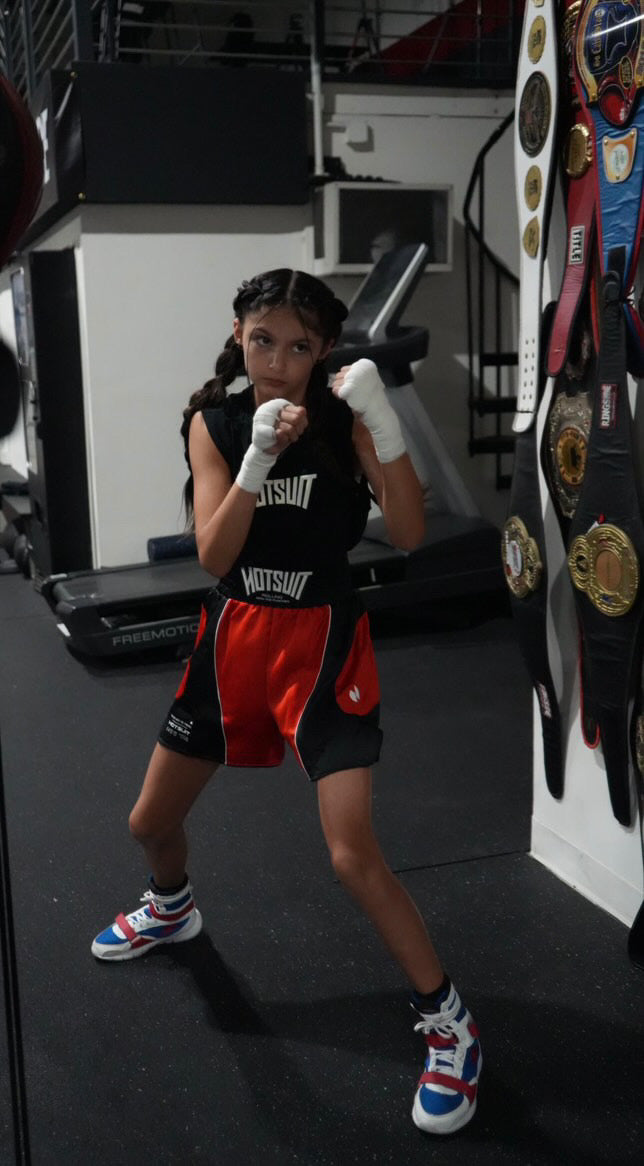We sat down for a boxer interview to discuss the realities of pro boxer training, the science of recovery, and the gear that makes a real difference. This is a look inside the fighter mindset.
The Daily Grind: A Glimpse into Pro Boxer Training
How do pro boxers train? The answer is far more comprehensive than just hitting a bag. The daily grind is a structured combination of skill work, conditioning, and strategy.

More Than Just Punching: The Importance of Roadwork and Conditioning
While technical boxing skill is paramount, it's nothing without the engine to back it up. That's why early morning roadwork (running) and intense conditioning circuits are non-negotiable parts of pro boxer training.

This foundational work builds the cardiovascular base needed to stay explosive, round after round. It builds the endurance that separates champions from contenders.
The Role of a High-Tech Sweatsuit in Maximizing Every Session
Efficiency is everything in a training camp. Many professional fighters incorporate a high-tech sweatsuit into their warm-ups and conditioning drills.

It's not just about cutting weight; it's about accelerating the warm-up process. A quality suit helps raise muscle temperature faster, ensuring the body is primed for intense work and reducing the risk of injury. This focus on efficiency is a hallmark of professional preparation.
The Fighter Mindset: Forging Mental Toughness
The physical demands are immense, but what truly defines a fighter is their mentality. The fighter mindset is a blend of unwavering discipline and unbreakable resilience.
Discipline Over Motivation: The Key to Consistency
Boxing motivation can be fleeting. Some days you feel on top of the world; other days, the last thing you want to do is train.
A professional athlete knows that motivation is a luxury, but discipline is a necessity. It’s the commitment to show up and put in the work on the hard days that forges a champion. This relentless consistency is the true secret to success.
Visualization and Focus: Preparing for Battle
The fight is won long before stepping into the ring. Top fighters spend countless hours on visualization—mentally rehearsing combinations, defensive moves, and scenarios.
This practice builds focus and mental acuity, allowing them to react instinctively under pressure. It turns a chaotic fight into a familiar environment.
The Science of Recovery: Rebuilding for the Next Round
A brutal training session breaks the body down. It is in the hours and days that follow that a fighter is truly built. Smart recovery is just as important as the training itself.
Nutrition as Fuel: A Boxer's Approach to Diet
For a boxer, food is fuel, not just flavor. A carefully managed nutrition plan, rich in lean proteins, complex carbohydrates, and healthy fats, is essential for muscle repair and energy replenishment.

The right boxer diet ensures the body has all the building blocks it needs to adapt and grow stronger from the intense demands of training.
Active Recovery and Sleep: The Unsung Heroes
Recovery isn't just about resting. Light activities like stretching, foam rolling, or a gentle swim—known as active recovery—can help reduce muscle soreness and improve blood flow.
Above all, sleep is the ultimate performance enhancer. During deep sleep, the body releases growth hormone, which is critical for repairing tissues and consolidating new skills.
Gear That Matters: An Athlete's Perspective on Hotsuit
In a sport of inches and seconds, the right boxing gear can provide a tangible edge. We asked about the role of specialized equipment like Hotsuit in a professional training camp.
"It's About Efficiency": How Hotsuit Helps with Warm-Ups and Weight Management
The feedback was clear: it all comes down to efficiency. "When you have multiple sessions a day, you need to get warm fast and make every minute count."
A high-quality sweatsuit helps achieve an optimal state for training much quicker. It also makes managing weight throughout a long training camp a more controlled and predictable process. For gear that works as hard as you do, .
Durability for the Toughest Camps: Gear That Keeps Up
A professional training camp is grueling, and the gear must be able to withstand it. The durability of a sweatsuit is critical.
"You can't have equipment failing mid-camp." Gear that is built to last, that can be used day in and day out, is an essential part of a fighter's toolkit.
The Champion's Path is Paved with Sweat
There are no shortcuts on the path to becoming a champion. It is a journey defined by relentless training, an unbreakable mindset, and intelligent recovery. It is paved, quite literally, with sweat.
What aspect of the fighter mindset do you find most challenging to apply to your own training? Let us know in the comments.
Common Questions for Aspiring Boxers
How many hours a day do pro boxers train? A professional boxer's training is often split into 2-3 sessions per day, covering roadwork, strength and conditioning, and technical boxing skills. This can total anywhere from 4 to 6 hours of intense work daily.
What is the hardest part about being a professional boxer? Many fighters agree that the hardest part is the mental grind: the unwavering discipline required every single day, especially when dealing with injuries, setbacks, or the pressures of an upcoming fight.
At what age is it too late to start boxing? While starting young has its advantages, it's never too late to start boxing for fitness and self-discipline. Many successful amateur and even professional fighters began their journey in their 20s or later.
What's one piece of advice for someone starting their boxing journey? Focus on the fundamentals. Master the jab, the footwork, and the defensive basics before worrying about anything else. Consistency with the basics is the foundation upon which everything else is built. Start your own champion's journey today.







Leave a comment
All comments are moderated before being published.
This site is protected by hCaptcha and the hCaptcha Privacy Policy and Terms of Service apply.